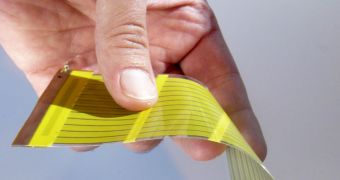Tempe, Arizona-based Nth Degree Technologies (NDT) is currently proposing the replacement of conventional light bulbs with sheets of flexible surfaces imprinted with a thin layer of LED devices.
Light-emitting diodes (LED) have been proposed as replacement for standard light sources for many years, but they have also been deemed impractical for a number of reasons. Now, NDT seeks to eliminate these drawbacks by creating printable LED.
The tiny devices would literally be printed on flexible surfaces, including clothing, paper, ceiling tiles and many others. This will enable people to install lights at any location in their homes or businesses, by simply applying a piece of cloth outfitted with LED on that particular surface.
When activated, the light sources look like glowing sheets of paper. The first product the NDT released is a lighting surface with an area of 2 by 4 feet (0.6 by 1.2 meters), Technology Review reports.
Selected customers are expected to receive the first devices, for evaluation purposes, by the end of this year. Depending on the results, the company will either go back to the drawing board and make improvements, or will begin commercializing the devices at a large scale.
NDT president and CEO, Neil Shotton, explains that the costs associated with producing/buying printed LED surfaces are in the same range as those of fluorescent light bulbs and other similar fixtures. This will make them very competitive when they reach the market.
Unlike other light sources, the new devices can be used to emit light from curved areas and irregular surfaces, which opens up new lighting pattern options. This could have significant applications in art galleries, for example, where lighting is oftentimes use to emphasize artists' creations.
“It's a new kind of lighting,” Shotton explains, saying that the printing process the company set up enables easy variation in color and brightness for the LED surfaces. The diodes themselves are produced from a wafer of gallium nitride.
The only drawback plaguing these light sources at this point is the fact that they only produce about 20 lumens per watt of energy, as opposed to the 80 lpw that fluorescent lights release. In the near future, the company plans to work on improving this efficiency level, further boosting the devices' performances.

 14 DAY TRIAL //
14 DAY TRIAL //